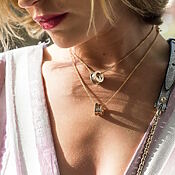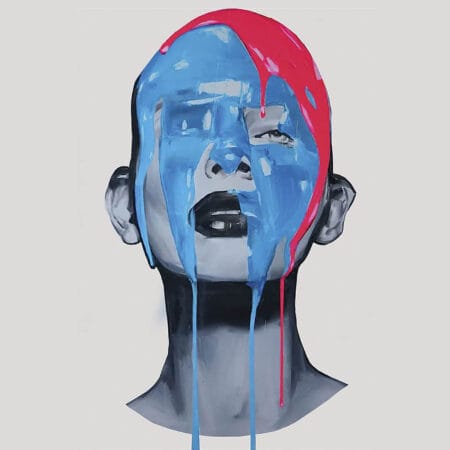Throughout history, artistic movements, with their respective philosophies, have always contributed to influencing other areas in terms of design language. This is also true of jewelry making , whose results have evolved from simple accessories to artistic statements that reflect stylistic periods, social movements, and cultural trends.
From the archaic motifs of ancient civilizations to the bold, geometric patterns of today, the development of jewelry is inextricably linked to art history. From the organic lines of Art Nouveau to the geometric elegance of Art Deco to the minimalist aesthetics of modernity: each era has left its own character in the jewelry. And that is exactly what we will devote ourselves in this article.
The antiquity - jewelry as insignia of spirituality, power and status
Art has had an impact on jewelry since the time of ancient societies, when jewelry was more than one way to look good; It was also a sign of spirituality, power and status. In ancient Egypt, jewelry had a deep symbolic meaning. The patterns were based on nature and life after death.
The eye of the Horus, Skarabäen and Ankhs were popular motifs. They mostly consisted of gold and were occupied with colorful gems such as lapislazuli, turquoise and carneol.
Some of the earliest societies, such as the Sumerians , Akkadians , Babylonians , and Assyrians , produced exquisite jewelry that displayed their wealth, status, and spiritual beliefs. As early as 3000 BC, people wore jewelry to look good, believing it would protect them from evil and demonstrate their divine love. They achieved a high level of artistry, employing techniques such as filigree, granulation, and enameling.
The Etruscans were real metal smiths. They were excellent in working with iron, tin, copper, silver and gold, and they were also experienced in melting bronze. These techniques come into its own in the gold jewelry of the Etruscans. These pieces show how precisely they were and how well they could make designs and patterns with astonishing love for detail.
Myths and nature also affected the jewelry in ancient Greece and Rome . Greek jewelry often had elaborate patterns of animals, leaves and laurel wreaths that stood for victory, protection and eternity. Roman jewelry, on the other hand, was strongly influenced by Greek art. There were large, striking pieces of gold, pearls and colored stones that should show power and prestige.

Image source: Ana Al'ain, CC BY-SA 4.0, via Wikimedia Commons
Precolumbian jewelry: craftsmanship rooted in nature and culture
Before Columbus' arrival, precolumbian jewelry practices - which extended over several Meso -American and South American cultures - showed a strong connection to nature, spirituality and social position. Cultures such as the Maya , Aztecs and Inka are known for their magnificent metal work and complex designs made of gold, silver and copper for the production of jewelry. These companies were convinced that jewelry was a strong sign of status, identity, spirituality and the connection to the divine.
Jewelry was worn by the elite of these companies - including kings, priests and warriors - as a status symbol and as a tool for calling supernatural protection. Pieces such as chest muscles, nose rings, ear coils and bracelets, which often represent topics from deities, animals and sky bodies, were painstakingly produced.
The Aztecs, for example, estimated turquoise and used it in complex mosaics and amulets, to which allegedly healing properties were attributed. Like other renowned goldsmiths, the Inca's exquisite works created that should capture the sun god's mystical essence.

Image Source: Gary Todd by Xinzheng, China, CC0, via Wikimedia Commons
Middle Ages - Tr Terms & Conditions Arer Wealth
Jewelry was still a status symbol in the Middle Ages, plus a religious commitment and an artistic expression. It included modest wood carvings and magnificent gold crosses with expensive stones. Jewelry was typically "Tr Terms & Conditions Arer Wealth" . Since there was no banking, jewelry served to store assets. Many pieces of jewelry had to withstand everyday life and were therefore made robust.
Jewelry was strictly regulated. Certain materials and styles were socially exclusive. Peasants were forbidden from wearing gold rings, while nobles were permitted to wear precious stones. Medieval civilization was hierarchical, and these regulations reflected that.
Religious symbols dominated the jewelry design at the time. Crosses, saints and biblical topics were common. They protected against diseases and evil spirits and were a creed. Impressively diverse materials were used. Bronze, copper and tin were used, but the most popular were gold and silver. Artistically manufactured semi -precious stones, glass, bones and wood were estimated next to rubies, sapphires and emeralds.
Many of these materials were traded over large distances. Mediterranean corals reached Scandinavia, while Baltic amber was used for jewelry all over Europe. Medieval goldsmiths processed the noble raw material very carefully. Filigree work, in which complicated patterns were created from the finest gold wires, peaked in the Middle Ages. By emailing , in which colored glass is melted on metal, colorful pieces of jewelry were created.

Image source: Zunkir, CC BY-SA 4.0, via Wikimedia Commons
engraving and chasing - the processing of metal surfaces with fine tools - was also These skills required years of training and were usually guarded as a family secret.
Elegant natural forms in Art Nouveau
Anyone who appreciates unique and interesting jewelry should definitely consider the characteristics of Art Nouveau. With its flowing lines and original ideas, this style shaped jewelry making in the late 19th and early 20th centuries.
Small designs inspired by flora and fauna were made by artistic goldsmiths.
Excellent materials and artistic talent combine to form harmonious works. The artisans reinterpreted the natural beauty and made jewelry that goes far beyond mere accessories. Your vision combined organic beauty with precise processing.
Renaissance - the return of classic elegance
Jewelry during the Renaissance reflected the revival of classical art and the aesthetics of the time. Renaissance jewelry was characterized by religious and mythological themes , meticulous craftsmanship, and the use of precious metals. It was inspired by the art and culture of ancient Greece and Rome. Using enamel, pearls, and precious stones, jewelers of the time created elaborate necklaces, brooches, and rings, often featuring religious or mythological themes.
The camera , a decorative stone or a shell with a sublime picture or a sublime scene was a trademark of the Renaissance jewelry. Due to their high value, many families kept these objects as heirs for many years. Personalized jewelry with motifs such as family coat of arms and monograms was also very popular in the Renaissance.
The baroque period: opulence and rich decorations
The Baroque period, known for its opulence, theatrical flair, and majesty, lasted from the late 16th to the early 18th century. Bolder and more elaborate jewelry, reflecting the luxury and power of the time, replaced the more restrained styles of the Renaissance during this period.
Complex, flowing designs were a trademark of baroque jewelry. It often contained huge jewels that were embedded in artistic gold versions. The preferred gemstones for baroque decorations included pearls, rubies, emeralds and diamonds. During this time jewelry was an explanation of social and economic status and the exquisite taste.
Victorian era - romantic transfigurations and industrial departure
Victorian jewelry reflected the spirit of innovation and transformation of this era, named after Queen Victoria of England. Each of the three main periods of the Victorian era—the Romantic, the Sumptuous, and the Aesthetic—is known for its unique style and diverse influences.
Love, nature, and sentimentality had a significant influence on jewelry during the Romantic period (1837–1861). Popular pieces included rings, brooches, and lockets featuring floral motifs, birds, and hearts; these often contained a lock of hair or a hidden message. Although colored gemstones such as turquoise, amethyst, and garnet were popular, "mourning jewelry" made of jet and onyx became particularly sought after following the death of Prince Albert.
More solemn and elaborate decorations were characteristic of the Great Period (1861–1885), which was marked by the Queen's mourning. Comingos , heavy gold jewelry, and black jewelry were popular during this time, as it was primarily concerned with mortality and remembrance.
Lighter, more delicate patterns regained popularity during the Aesthetic Period (1885–1901), which emphasized artistic expression and craftsmanship. The elaborate designs and natural motifs of Japanese art and culture had a significant influence on the jewelry of this era.
Art Nouveau: imaginative natural forms

image source: Luisella Planeta Love Peace 💛💙 on Pixabay
In contrast to the stiff industrial designs of the previous epoch, Art Nouveau jewelry emphasized natural elements and was characterized by organic shapes with flowing lines. René Lalique and Georges Fouquet were two renowned jewelers who revolutionized the jewelry industry with its groundbreaking use of enamel, glass and semi -precious stones. Her creations were not only functional, but were also considered real works of art.
Flowers, leaves, insects and fantastic creatures were frequent motives in Art Nouveau jewelry, the movement and fluid ability emphasized. The opals used in jewelry, moonstones and pearls gave him a surreal character that appealed to people who were looking for something artistic and unique.
If you can get excited about special unusual jewelry , you should definitely deal with the characteristics of the Art Nouveau.
Art Deco: Geometry hits glamor
Unlike the flowing Art Nouveau, in the art-depot movement of the 1920s and 1930s, geometric forms and symmetrical patterns shaped the creations.
Platinum and white gold formed the basis, refined by diamonds, emeralds and sapphires. These jewelry embodied the spirit of a dynamic era: precision met luxury, progress for elegance.
The Art Deco style, popular during the Roaring Twenties and the Great Depression, emphasized splendor, glamour, and modernism. Art and architecture from ancient Egypt and the Far East, as well as industrial growth, had an enormous influence on the movement.
The symmetry and order of Art Deco jewelry designs were typically embellished with diamonds, emeralds, rubies, sapphires, and platinum or white gold. Easily accessible, mass-produced jewelry was also made possible by the widespread introduction of new materials such as Bakelite and lacquer.
Bauhaus: Functionality with a clear form
The Bauhaus movement shaped the jewelry design with its radically reduced approach and thus constitutes the contrast to abstract art . Functionality was the focus, with materials such as steel and bakelite challenging traditional jewelry performances.
The fusion of art and craft led to designs that emphasized the essential and eliminated superfluous ornamentation. Clear forms and a precise material aesthetic characterized these pieces of jewelry . The movement developed a new design philosophy that defined beauty through simplicity and functionality.
Surrealism: imagination and love for the dreamlike
The influence of Surrealism on jewelry strongly motivated designers and artisans to create works that challenged conventional notions of design and technique. Jewelry evolved into a means of expressing the subconscious and exploring creative boundaries. Dreamlike themes such as eyes, lips, and fantastical creatures—depicted in unusual forms, materials, and techniques—are frequently seen in Surrealist jewelry.
Surrealistic jewelry still inspires modern designers not only to create exquisite, but also provocative and deeply significant works.
Two strong personalities in the areas of art and fashion, Salvador Dalí and Elsa Schiaparelli , have significantly shaped the jewelry design. Dalí, who is known for his surrealistic paintings, transferred his innovative and often unconventional vision to jewelry and created colorful, provocative and occasionally surreal creations. His partnerships with jewelry designers, such as the well -known "lobster dress" , which he created together with Edward James , blew up the limits of conventional jewelry design and questioned Terms & Conditions

Arroser, CC0, via Wikimedia Commons
The groundbreaking fashion designer Elsa Schiaparelli worked with artists like Dalí to produce striking, creative jewelry that matched her avant -garde clothing designs. The daring use of colors, unexpected materials and amusing motifs - like her well -known "shoe hat" , which she created together with Dalí - shaped Schiaparelli's jewelry. Dalí and Schiaparelli together gave the jewelry design of artistic expression, inventiveness and ingenuity.
Pop art: colorful expression
Anyone who has managed to find themselves and develop their own style often relies on bright colors. And that's exactly where pop art comes on. This type of art revolutionized jewelry design with its colorful and playful approach.
Everyday objects and consumer culture inspired designers into creations that blurred boundaries between high culture and popular culture. Plastics and innovative materials enabled new designs with bright colors and comic motifs. Furthermore, pop art jewelry transformed from a pure accessory to a statement that reflected the zeitgeist of the 1950s and 1960s. The movement enriched the jewelry world with a lively, unconventional aesthetics.
Minimalism: clear shapes and stylish elements
Minimalism subtle elegance and still has a big impact on jewelry design. Due to this aesthetic change away from the extravagant and complicated styles of recent years, jewelry has gained modernity and sophistication. Geometric shapes, smooth surfaces and the emphasis on high -quality materials such as gold, silver and diamonds are plentiful in minimalist jewelry.
Minimalism was taken over by designers and artists such as Elsa Persetti and Sarah Graham , who have created classic, elegant and adaptable works. For people who appreciate the elegant look and classic charm, minimalist jewelry is still trendy.
Through his "less, but better" concept, Dieter Rams had a significant influence on jewelry design. His focus on elegance, simplicity, and utility inspired jewelry designers to create timeless, functionally sound pieces, rather than merely producing aesthetically pleasing items.
Ted Muehling , on the other hand, is a jewelry designer best known for his simple, nature-inspired organic creations. His pieces, crafted from precious metals like gold and silver, often feature delicate and intricate structures such as twigs, leaves, and insects. Muehling's influence on jewelry design lies in his ability to faithfully represent the beauty and essence of the natural world in his work. In this way, he can motivate other designers to explore organic forms and textures in their own creations.
Its meticulous attention to detail and processing attaches importance to quality and artistry in every piece and have set a benchmark for excellence in modern jewelry design.
Postmodernism: cultural diversity
From the 1970s, postmodernity brought a new variety into jewelry design. It mixes cultural influences, styles and materials in an unconventional way. Designers are inspired by historical eras, ethnic traditions and pop culture.
Jewelry combine elements of different times and cultures. Unusual materials such as plastic or finds expand the design options. The movement celebrates individual expression and creates unique creations that reflect the complexity of global cultural flows.

Owner and Managing Director of Kunstplaza. Publicist, editor, and passionate blogger in the field of art, design, and creativity since 2011. Successful completion of a degree in web design as part of a university program (2008). Further development of creativity techniques through courses in free drawing, expressive painting, and theater/acting. Profound knowledge of the art market through many years of journalistic research and numerous collaborations with actors/institutions from art and culture.

















